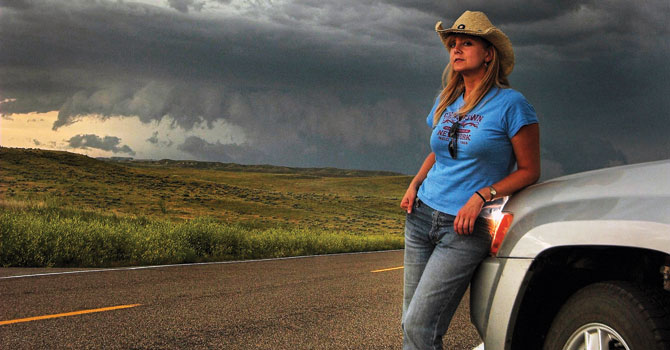That’s the response I get from many people, when they hear I’m a stormchaser. I understand the reaction. After all, my childhood training, from when I was a little girl visiting my grandmother in rural southeastern Minnesota, was: if you see a green sky and the sirens go off, run to the basement. Instead, I now drive the other way—closer to the storm.
 Weather daredevil and novelist Jenna Blum
Weather daredevil and novelist Jenna Blum
It’s precisely because of those early visits to Minnesota that I became fascinated with severe weather. When I was four, I saw a tornado at night while everyone else was asleep. I hid under my grandmother’s davenport and watched the black rope tornado traverse her picture window, from left to right. While it was terrifying, it was also—to a little girl so obsessed with the Wizard of Oz that for years I was mad at my mom for not naming me Dorothy— terribly exciting.
I subsequently spent much of my life trying to see another tornado. Eventually, five years ago, I joined a professional storm tour group: Tempest Tours, out of Arlington, Texas. I discovered that chasing isn’t about outrunning tornado after tornado as they drop from the sky—although sometimes, despite your best efforts, that does happen. As one of my chase partners, photographer Marcia Perez, says: "Sometimes you chase the storms. Sometimes they chase you."
More often, though, chasing is a game of atmospheric chess, putting yourself in position for storms to go up. Tornadoes occur anywhere in Tornado Alley, from Texas to North Dakota. I’ve played the hurry-up-and-wait game—watching the sky for a cumulus puff to develop into a supercell—all across this beautiful country of ours. To me, that’s part of the wonder of chasing: visiting the Great Beyond, the lonesome, majestic parts of America.
Then there’s the almost instant bonding that occurs when you spend 24-7 in a van, in the wilderness, in dangerous situations with people who all share your love for the astonishing power of nature. Of course, there are the storms, too—countysized sky sculptures that look like alien motherships and glow all colors: dark purple, menacing blackbrown, luminescent green, or glacial aqua.
And, perhaps dearest to a writer’s heart, there are the details. "God is in the details," according to Emerson, and he may be right. Thanks to my stormchasing, I know how it feels when you’re driving toward a storm: part exhilaration, part sheer fear. Or the fact that near a tornadic supercell, you sometimes hear thunder that whipcracks across the sky and wind that shrieks in the telephone wires.
But always, always, you also hear birds, and this sums up for me the whole experience: surprising, unexpected, and oddly peaceful, the way you can feel in churches, when you stand in front of something so much bigger than yourself and feel a profound sense of awe.

